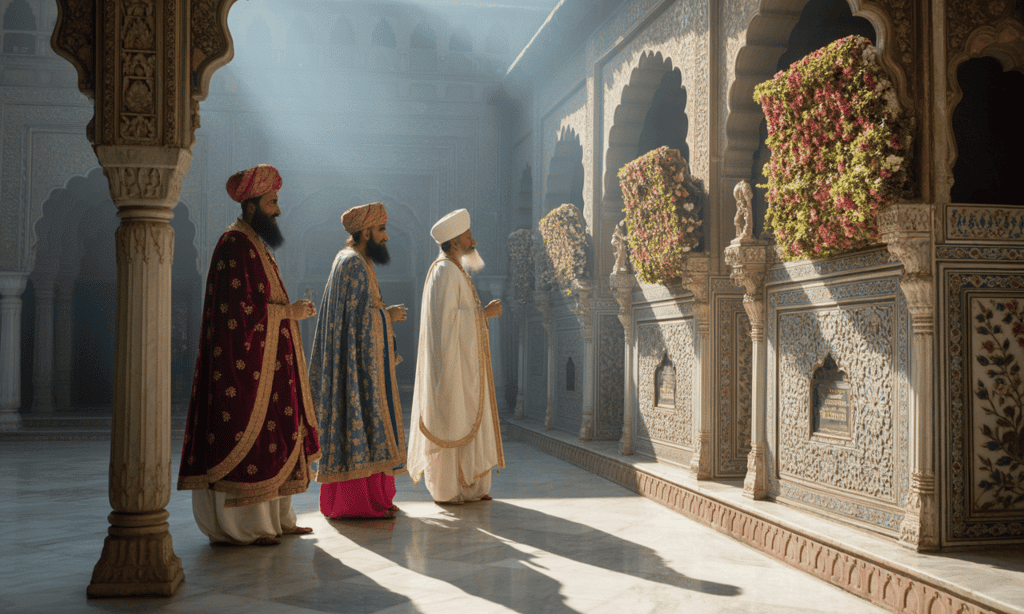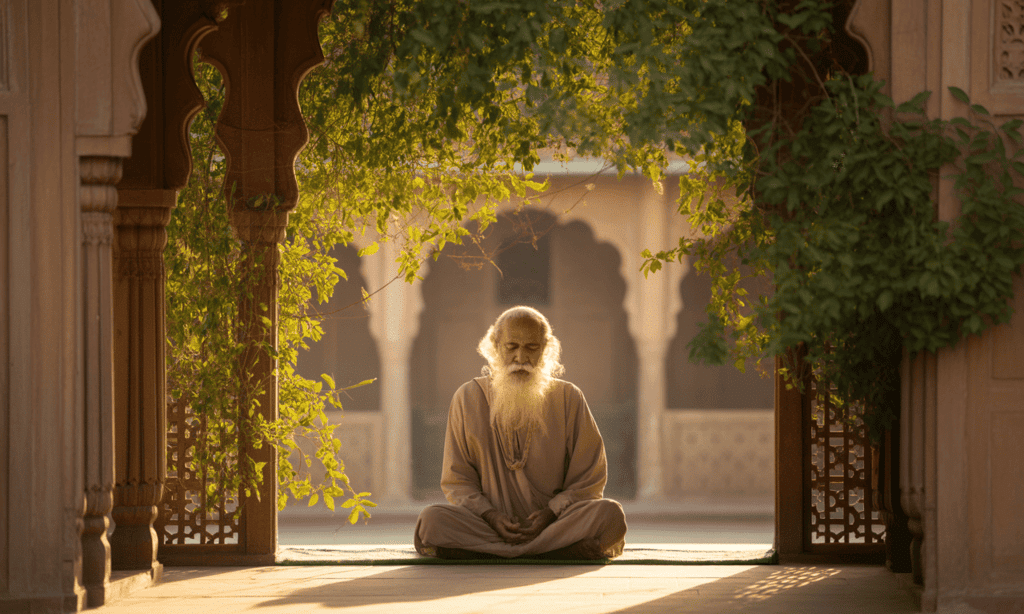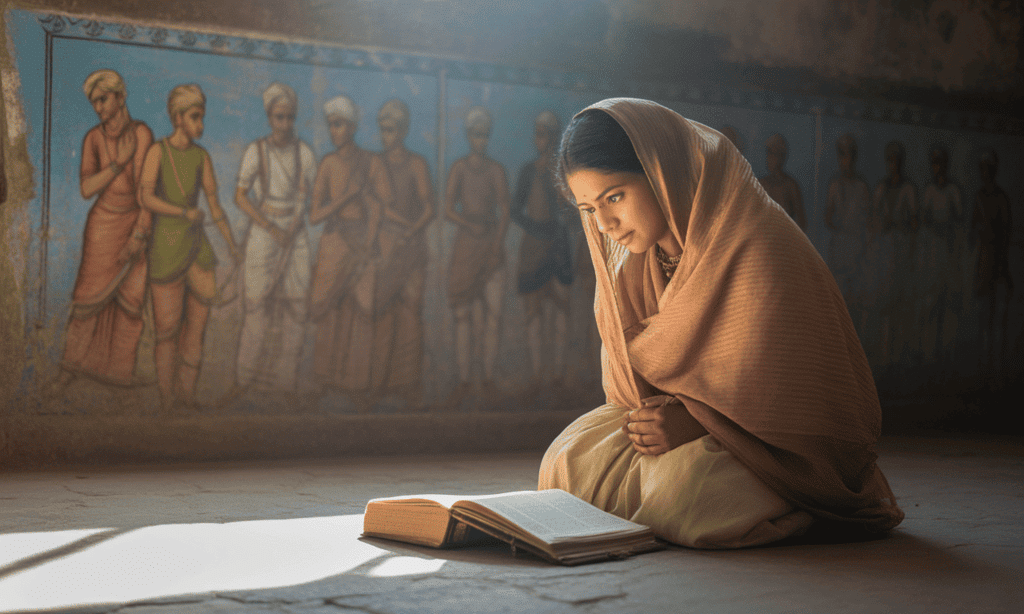Sure Shot Questions for Board Exams: Bhakti-Sufi Traditions | History Class 12 - Humanities/Arts PDF Download
Introduction
This chapter focuses on how devotion (bhakti) in Hinduism and mysticism (sufism) in Islam shaped medieval Indian society. This chapter includes some important questions and answers to help you prepare for class tests, school exams, or board-level assessments with key, repetitive questions.
Key Questions
 View Answer
View Answer 
The Alvars were Tamil poet-saints devoted to Vishnu, and the Nayanars were poet-saints devoted to Shiva. They launched early Bhakti movements in South India, singing hymns of devotion (in Tamil) at village shrines. Chola kings actively patronised both traditions:
Granted land and funds for constructing great temples to Shiva and Vishnu (e.g. at Chidambaram, Tanjavur and Gangaikonda Cholapuram)
Sponsored bronze icons and temple rituals to honour these saints’ visions
Cholas legitimised their rule by building temples and enshrining these popular saints in the state cult
 View Answer
View Answer 
- The Nalayira Divya Prabandham is a collection of 4,000 Tamil devotional hymns written by the 12 Alvars between the 5th and 8th centuries.
- It was compiled by the theologian Nathamuni in the 9th to 10th centuries.
- This anthology celebrates the various forms of Vishnu and is highly revered among Sri Vaishnavites. It is often referred to as the “Tamil Veda” or “Dravida Veda”, signifying its religious significance comparable to the Sanskrit Vedas.
- The Alvars received support from Tamil chiefs, including the Chola dynasty, who contributed to the establishment of Vishnu temples and the promotion of their traditions
3. How did Karaikkal Ammaiyar become a leading figure in the Nayanar tradition?
 View Answer
View Answer 
Karaikkal Ammaiyar (6th–7th century) was a devoted follower of Shiva and one of the earliest female saints in Tamil Shaivism. She became a prominent figure in the Nayanar tradition through the following actions:
- She renounced worldly life, embracing extreme asceticism, which included practices like dancing naked in cremation grounds.
- Her deeply personal hymns in Tamil were preserved by later Nayanar poets.
- She challenged traditional caste and gender norms, expressing her devotion in unique ways.
- Through her ascetic lifestyle, heartfelt devotion, and poetic contributions, she emerged as a key female figure in the Nayanar tradition.
 View Answer
View Answer 
Basavanna (c.1106–1168) was a 12th-century Shaiva poet-philosopher and social reformer in Karnataka. He was originally a minister in the Kalachuri court and founded a new Shaiva devotional movement. His followers worshipped Shiva and wore a personal linga on their bodies. They came to be known as:
Virashaivas (heroes of Shiva)
Lingayats (wearers of the Linga)
5. What Brahmanical ideas or practices did the Lingayats challenge?
 View Answer
View Answer 
Lingayats rejected many orthodox Hindu beliefs and practices, especially those upheld by Brahmanas:
Rejected caste hierarchy and ritual pollution
Denied the theory of rebirth and the varna system
Believed in uniting with Shiva after death (no return/rebirth)
Rejected cremation, opted for burial instead
Supported widow remarriage and post-puberty marriage
 View Answer
View Answer 
- Andal (devotee of Vishnu) only woman among the twelve Alvars; credited with the Tiruppavai hymns
- Karaikkal Ammaiyar (devotee of Shiva).
 View Answer
View Answer 
Both:
Composed Tamil devotional poetry
Rejected caste and ritual orthodoxy
Difference:
Theological focus: Vishnu (Alvars) vs. Shiva (Nayanars
 View Answer
View Answer 
Silsila: A spiritual lineage or chain of masters linking a living shaykh (Pir) back to the Prophet Muhammad. Symbolises the transmission of spiritual blessings and teachings.
Ziyarat: Pilgrimage to the shrine of a saint (dargah). Often done on the saint’s death anniversary (urs), marking his union with God.
 View Answer
View Answer 
Sufi saints had mass spiritual authority and moral credibility
Kings gained legitimacy and popular support through association
Many rulers built tombs near Sufi shrines
Patronage of dargahs enhanced their divine image and prestige

 View Answer
View Answer 
- Development of Sufi literature and spiritual manuals on Qur’anic commentary and meditative practice
- Establishment of institutional centres (khanqahs) led by sheikhs, where disciples received spiritual training and guidance
 View Answer
View Answer 
His personal piety, charity, and miracles drew admiration
Supported by Mughal rulers like Akbar, who visited and patronised the shrine
Located on a major trade route, it attracts many visitors
Became the most venerated Sufi shrine in India
Due to the saint’s spiritual reputation, royal patronage by the Mughals, and its location on a major trade route between Delhi and Gujarat.
 View Answer
View Answer 
Simplicity and universality of the Five Pillars
Egalitarian principles and lack of caste
Adaptation to local cultures and languages
Sufi missionaries’ message of love and charity
Royal patronage of mosques and religious institutions
 View Answer
View Answer 
Originated as a response to the growing materialism and ritualism of the Caliphate
Sufis emphasised:
Devotional love and inner spirituality
Ascetic life and personal experience of God
Criticism of rigid theology and external rituals
Use of music (sama), dhikr (remembrance), and poetry
 View Answer
View Answer 
Personal devotion to one God
Rejection of caste and priestly dominance
Use of vernacular languages for mass outreach
Inner faith over external rituals
Social equality and universal brotherhood
Worship through love, surrender, and simplicity
 View Answer
View Answer 
Be-Shari’a and Ba-Shari’a refer to two distinct traditions within Sufism.
- Ba-Shari’a Sufis adhered to the formal shari’a (Islamic law) in their daily lives.
- Be-Shari’a Sufis intentionally disregarded legal norms to seek mystical experiences.
Both traditions shared a focus on ascetic discipline but differed in their approach to religious conformity:
- Be-Shari’a Sufis often lived as wandering ascetics, known as qalandars or malangs, outside orthodox practices.
- Ba-Shari’a Sufis remained within the bounds of Islamic law.
Despite their differences, both groups emphasised love and devotion to God over mere ritual observance. They also:
- Criticised scholasticism and caste distinctions.
- Utilised Urdu and local languages for their teachings.

 View Answer
View Answer 
A murshid (Arabic for "guide") is a spiritual teacher or sheikh in Sufism. The relationship between a murshid and a disciple, known as a murīd, is significant for several reasons:
- A disciple pledges allegiance (bay‘ah) to the murshid, committing to follow their spiritual guidance.
- The murshid transmits spiritual knowledge and barakah (blessing) directly to the disciple.
- This mystical transmission of "light" from the murshid to the disciple is viewed as the most authentic path to God.
- Devotion to the murshid is considered equivalent to devotion to God, making the murshid a vital link in the disciple's spiritual journey.
 View Answer
View Answer 
Historians suggest that the Bhakti movement arose mainly due to:
- Reaction to social inequality: It challenged the rigid social order and caste oppression, particularly against the Rajput-Brahmin dominance.
- Socio-economic changes: Urbanisation and the migration of artisans and peasants created a new middle class that was dissatisfied with traditional hierarchies.
- Message of equality: Bhakti's focus on personal faith and equality resonated with lower castes who were often excluded from Brahmanism.
- Inter-religious influences: Ideas from Islam, such as the concept of one God and brotherhood, also shaped the movement.
The Bhakti movement emerged as a response to the demands of common people for religious reform and greater social equity, driven by factors like social inequality, caste oppression, and the influence of Sufism.
18. How did Kabir describe the ultimate reality in his poems?
 View Answer
View Answer 
Kabir's poetry uses imagery from both Hindu and Muslim traditions to illustrate the concept of God. Key aspects of his depiction of the ultimate reality include:
- Referring to the divine by many names, such as Allah, Ram, and Hazrat.
- Exploring the unity between the individual soul and the universal spirit.
- Emphasising love and devotion over ritualism.
- Utilising mystical expressions, like "the lotus which blooms without flower" and "the fire raging in the ocean," to convey profound experiences.
Through his verses, Kabir challenges distinctions made between different religions, advocating for a shared understanding of the divine.
 View Answer
View Answer 
- Tamil Bhakti saints enjoyed close ties with the Chola and other South Indian dynasties. Chola rulers (9th–13th c.) openly supported the Alvars and Nayanars by building grand temples dedicated to Vishnu and Shiva, many at sites venerated in the saints’ hymns.
- Rulers like the Cholas built temples and supported the worship of Vishnu and Shiva. Bhakti saints helped legitimise royal power and were honoured with temple processions and hymns.
- These kings endowed land and wealth to Brahmins and Bhakti priests, and even installed bronze images of the saints in temple processions. In effect, the Cholas co-opted Bhakti imagery to legitimise their rule: they proclaimed divine sanction by recreating the saints’ Tamil-language devotional vision in stone and metal.
- At the same time, the widespread popular worship of these poets helped the rulers win peasant loyalty. Thus, the Bhakti saints and the state formed a mutually reinforcing relationship in medieval Tamil Nadu.
 View Answer
View Answer 
- Sufis were crucial missionaries of Islam in India. From the 12th century onward, Sufi orders (especially the Chishtī, but also Suhrawardī, Naqshbandī, etc.) established khanqahs (hospices) in cities and villages.
- These khanqahs offered free food, shelter and spiritual counsel to anyone, cutting across caste lines.
- Sufi masters also translated Qur’anic and mystical texts into local languages and incorporated local music and poetry in worship.
- By building egalitarian communities around love of God and service to the poor, Sufis attracted large followings among non-Muslims.
- Scholars note that Sufi khanqahs in India provided “spiritual guidance, psychological support, and counselling that was free and open to all people.”
- Their emphasis on compassion and humanism (and the diffusion of Islam’s message in vernacular culture) helped the faith take root across the subcontinent.
- Sufi khanqahs provided food, shelter, and spiritual teachings to all, cutting across caste and religion. They spread Islam’s message of love and service in vernacular languages.
Tips for Preparation
- Understand Key Saints and Movements: Focus on individual saints’ teachings, especially Kabir, Nanak, Basavanna, Andal, and Chishti saints.
- Learn Terms and Concepts: Definitions of Silsila, Murshid, Ziyarat, Bhakti, Langar, and Khanqah often appear in short questions.
Focus on Themes, Not Just Facts: Questions are often analytical (e.g., role of women, impact on caste), not just factual. Prepare points with examples. - Use a Timeline or Map: Know approximate periods and locations (e.g., Cholas in South, Chishtis in Ajmer).
- Highlight Syncretism: Stress how Bhakti and Sufi movements created cultural unity and challenged rigid systems.
- Prepare Previous Year Questions: Many are repeated with small rephrasing (e.g., role of Alvars/Nayanars, reasons for Sufi popularity).
- Practice Answer Framing: Especially for 6- or 8-mark questions. Use point-wise structure, examples, and a balanced conclusion
|
30 videos|274 docs|25 tests
|
FAQs on Sure Shot Questions for Board Exams: Bhakti-Sufi Traditions - History Class 12 - Humanities/Arts
| 1. What are the main principles of the Bhakti movement? |  |
| 2. Who were some prominent figures in the Sufi tradition and their contributions? |  |
| 3. How did the Bhakti and Sufi traditions influence Indian culture? |  |
| 4. What role did poetry play in the Bhakti and Sufi movements? |  |
| 5. What are the similarities and differences between the Bhakti and Sufi traditions? |  |





















